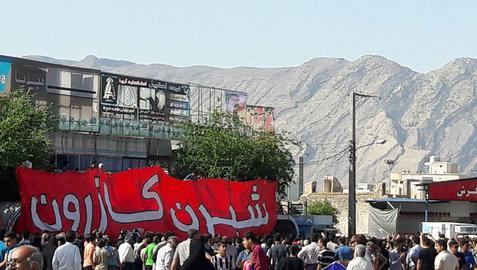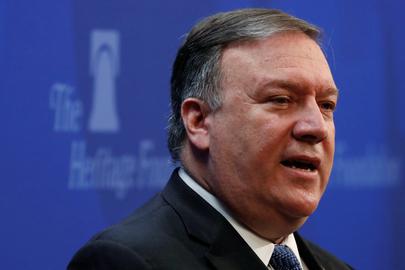This is the fifth article in IranWire’s series Decoding Iranian Politics. The series examines the building rift between Iran’s various political factions, goes behind the scenes of the country’s fiercest political scandals and assesses what impact the complex web of government institutions has on Iranian politics today, as well as taking stock of some of the most defining moments in recent history.
What You Need to Know about Changes in County Divisions and its Impact on Security
A controversial proposal to split the county of Kazerun in two has led to bloody protests.
On Wednesday, May 16, demonstrations in the city of Kazerun in the southeastern province of Fars turned violent when police and security forces fired shots into the crowd. Iranian authorities have confirmed that two people have been killed and 48 have been wounded. But protesters say the number of casualties is higher than what has been suggested in official reports.
Responding to the protests, the interior ministry announced on May 17 that plans to divide the county of Kazerun will be suspended pending further revision.
Residents have been protesting for nearly a year against new plans to change the city’s boundaries, which would place certain historically-important areas outside the city of Kazerun. People view these areas as being significant parts of their cultural identity.
But many observers view the Kazerun protests as a sign of people’s general dissatisfaction with the country’s economic conditions — a widespread feeling that also fueled protests that took place across Iran in late December and early January 2018.
Are Protests Against Administrative Divisions Unprecedented?
Administrative divisions — whether cities, counties or districts — have often been the source of local tensions in Iran. From time to time, these tensions have led to public protests in different cities.
The first major protest of this type during Ayatollah Khamenei's time as Supreme Leader — which began in 1989 — took place in July 1994 in the city of Qazvin, northwest of Tehran. Protests erupted when the parliament rejected plans to form the Qazvin province, which was to be comprised of the county of Qazvin and other counties. Some protesters attacked and damaged public offices, and eventually, the Islamic Revolution Guard Corps stepped in to stop the demonstrations. However, three years later, in 1997, authorities formed the new province of Qazvin.
The most widespread protests against changes to administrative divisions took place in the early 2000s, prior to the division of Khorasan province, the largest province of Iran before it was divided into three provinces in 2004.
In the years leading up to the establishment of the three new provinces — of North Khorasan (northeastern Iran), South Khorasan (eastern Iran) and Razavi Khorasan (northeastern Iran) — protests were held in several cities in Khorasan province, including in Sabzevar, Ghoochan, Ferdows, Ghonabad, Gha’en, Torbat-Heydarieh and Torbat-Jam. People were unhappy with the planned boundaries of the three new provinces for a variety of reasons.
During the 2001 protests in Sabzevar, at least one protester was killed and dozens of people were wounded. In addition, protesters attacked government offices and destroyed part of the local railway.
Most recently, people expressed their dissatisfaction with administrative entities in Shahrud, northeastern Iran, staging a protest on May 20 in the city just a few days after the bloody protests in Kazerun. People took to the streets to voice their disagreement with government plans to transfer the city’s Road and Construction Department to the capital of the province, Semnan. The protesters believe if this transfer takes place, a number of local employees will lose their jobs. Since the Shahrud protests have not turned violent, they have not been widely covered by the media.
How Have Iran’s Administrative Divisions Changed since the Islamic Revolution?
Every Iranian province consists of several counties. Every county has at least one city, and a number of villages, and many counties have several.
In 1979, when the Islamic Republic was established in Iran, the country was comprised of 24 provinces and 165 counties.
After the revolution, authorities set up eight new provinces and dissolved one province. Iran currently has 31 provinces.
Since 1979, the following provinces have been created: Ardabil in 1993 (northwestern Iran), Qom in 1996 (south of Tehran), Gholestan in 1997 (northeastern Iran), Qazvin in 1997 (northwest of Tehran), North Khorasan and Razavi Khorasan in 2004 (northeastern Iran), South Khorasan (eastern Iran), and Alborz in 2010 (northwest of Tehran).
The number of Iran’s counties has significantly increased since the foundation of the Islamic Republic. To gain an understanding of the level and impact of this change, it is worth mentioning that the number of counties in Iran increased from 165 in 1979 to 363 in 1998 and 394 in 2011. The main reason for this increase is the pressure some politicians place on parliament, stemming from promises they have made during election campaigns to secure votes. They have successfully lobbied parliament to create new counties or even provinces.
Today, Iran’s counties number at 429, and there are ongoing demands to form new counties in different parts of the country. These demands provide a potential ground for tensions, as with what happened recently in Kazerun.
Why Is There Such Sensitivity around Administrative Divisions?
The economic situation is a key factor in driving widespread demand for change in administrative divisions.
In many parts of Iran people believe that the local budget is not fairly distributed throughout their province or county. This perception is usually more common in areas far from the province or county capital, places which have benefited less from local or national investments. As a result, people in these faraway parts want to be recognized as the inhabitants of a new county or province in order to have more control over their budget and resources. They believe that local resources they are entitled to are sent to other parts of the province or county. It is people with these grievances who express the greatest demands for changes in administrative entities.
Local conflicts between people belonging to different ethnic, tribal —and sometimes religious — groups also fuel demand for these changes. Many of these people do not want to live in the counties or provinces which are dominated by other ethnic, tribal or religious communities other than their own; they strive for the establishment of the counties or provinces that are independent from areas dominated by other groups. On the other hand, sometimes people belonging to different ethnic, tribal or religious groups resist attempts for their counties or provinces to be split up, especially if it includes an area of economic, historic, or even religious importance (for instance, if a holy shrine is to be separated from their county or province and “relocated” in a new administrative area).
However, on many occasions, tensions over administrative divisions stem from a suggestion for such change from a member of parliament. During parliamentary election campaigns, some candidates promise parts of the electorate that they will pave the way for the formation of a new county or province. When such candidates are elected, their efforts to fulfill their electoral promises can potentially trigger protests from local people who do not agree with the proposed divisions.
This is, indeed, exactly what happened in the county of Kazerun, when the efforts of city’s representative in the parliament led to a plan to break the county in two.
visit the accountability section
In this section of Iran Wire, you can contact the officials and launch your campaign for various problems

























comments